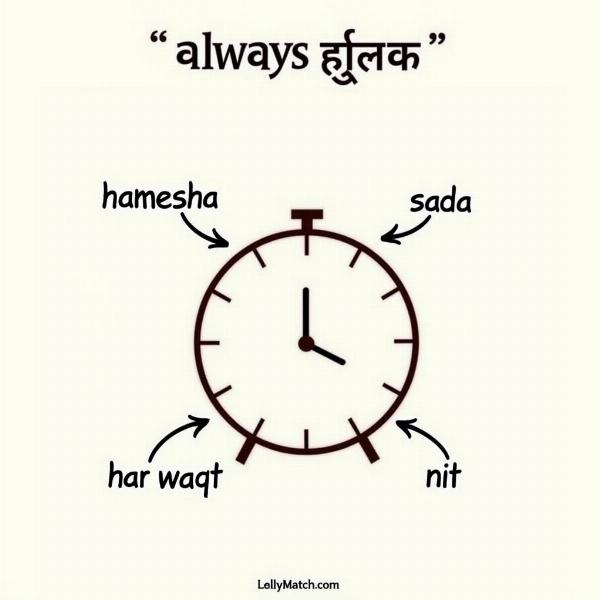Understanding the nuances of expressing “I am always” in Hindi can be tricky. It’s not a simple one-to-one translation, as the best choice depends on the context and what you’re trying to convey. “I am always” in Hindi isn’t just about literal meaning, but also about reflecting cultural appropriateness and conveying the intended emotion effectively. Whether you’re looking to say “I am always there for you,” “I am always happy,” or simply “I am always fine,” this guide will equip you with the various ways to express this sentiment in Hindi.
Expressing “I Am Always” in Different Contexts
The Hindi language offers several ways to express the English phrase “I am always.” The most accurate translation depends heavily on the specific situation. Let’s explore some common scenarios and their corresponding Hindi translations:
-
“I am always happy”: You can say “मैं हमेशा खुश रहता हूँ” (Main hamesha khush rehta hun) for a male speaker, or “मैं हमेशा खुश रहती हूँ” (Main hamesha khush rehti hun) for a female speaker. This literally translates to “I always stay happy.”
-
“I am always there for you”: A heartfelt way to express this sentiment is “मैं हमेशा तुम्हारे साथ हूँ” (Main hamesha tumhare saath hun), meaning “I am always with you.” For a more formal tone, consider “मैं हमेशा आपके साथ हूँ” (Main hamesha aapke saath hun).
-
“I am always fine”: A simple “मैं हमेशा ठीक रहता/रहती हूँ” (Main hamesha theek rehta/rehti hun) conveys this message clearly. You can also use “मैं हमेशा अच्छा/अच्छी हूँ” (Main hamesha achha/achhi hun), which means “I am always good.”
Choosing the Right Hindi Word for “Always”
While “hamesha” (हमेशा) is the most common translation for “always,” other options exist, each with subtle differences in meaning:
-
Sadā (सदा): This word also means “always” but carries a more formal and literary tone. It is often used in poetry and religious texts.
-
Nit (नित): This word implies “daily” or “regularly,” so it’s suitable when talking about habitual actions.
-
Har waqt (हर वक्त): This translates to “every time” or “all the time” and emphasizes consistency.
 Synonyms for Always in Hindi
Synonyms for Always in Hindi
Common Mistakes to Avoid
One common mistake is directly translating “I am always” without considering the context. For example, saying “Main hamesha hun” (मैं हमेशा हूँ) without specifying what you are always, sounds incomplete. Always ensure your sentence conveys the complete thought.
i am always there with you meaning in hindi
Another pitfall is using the wrong gender agreement. Hindi verbs conjugate according to the gender of the subject. Ensure the verb ending matches the speaker’s gender.
i am always good meaning in hindi
Mastering the Nuances of “I Am Always” in Hindi
Mastering the various ways to express “I am always” in Hindi opens up a world of expressive possibilities. By understanding the subtle differences between synonyms and considering the context, you can communicate your intended meaning accurately and respectfully.
i am always stay with you meaning in hindi
Conclusion
Expressing “I am always” in Hindi requires more than just a direct translation. By considering the context and choosing the appropriate vocabulary, you can convey your message accurately and effectively. Whether you’re expressing support, describing a habitual action, or simply stating your well-being, understanding these nuances will enhance your communication in Hindi. Remember to pay attention to gender agreement and avoid literal translations that might sound incomplete. With practice and attention to detail, you can confidently express “I am always” in various situations.
FAQ
-
What is the most common way to say “always” in Hindi? Hamesha (हमेशा) is the most common and versatile translation for “always.”
-
Is there a more formal way to say “always”? Sadā (सदा) is a more formal and literary term for “always.”
-
How do I say “I am always helpful” in Hindi? You could say “मैं हमेशा मददगार रहता/रहती हूँ” (Main hamesha madadgar rehta/rehti hun).
-
What’s the difference between “hamesha” and “nit”? While both convey a sense of continuity, “nit” (नित) implies a daily or regular occurrence, while “hamesha” is more general.
-
Why is context important when translating “I am always”? The meaning of “I am always” changes depending on what follows it. Context helps choose the most accurate and appropriate translation.
-
How do I ensure correct gender agreement when saying “I am always”? The verb ending needs to match the gender of the speaker. For example, a male speaker would use “rehta hun,” while a female speaker would use “rehti hun.”
-
What is a common mistake to avoid when translating “I am always”? Directly translating without specifying what you are always is a common mistake. Always complete the thought.
same as always meaning in hindi
i am always fine meaning in hindi
Meaning-Hindi.in is your one-stop solution for all your Hindi translation needs. We specialize in various translation services, including business and commercial document translation, certified and legal document translation, technical and user manual translation, website and localization services, educational and academic document translation, express translation, and specialized translation services. We ensure accurate and culturally sensitive translations, delivered with utmost professionalism. Contact us today for a free quote! Email: [email protected], Phone: +91 11-4502-7584. Meaning-Hindi.in is here to help bridge the communication gap!